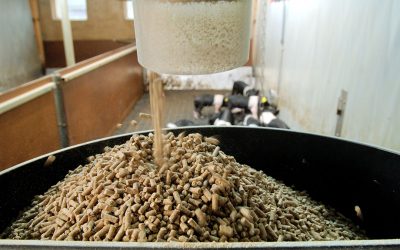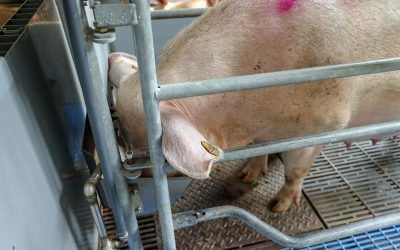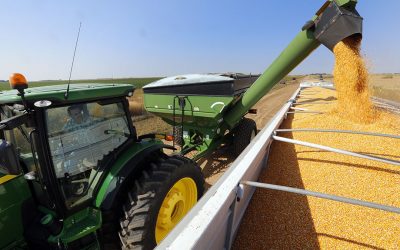Keeping moulds out of food and animal feed with propionic acid
The EU hygiene directive in force since January 2006 also applies to animal feed, requiring it to be in perfect condition. Animal feed products have to be free of mould and have a long storage life. Propionic acid is the ideal animal feed preservative. It is also an important element in the production of vitamin E. BASF has a long experience with propionic acid and Vanessa Holzhäuzer elaborates on the versatility of the acid.
By Vanessa Holzhäuser, BASF, Ludwigshafen, Germany
As everyone knows, you can’t count on the weather. Its
caprices may hit farmers hard. Too dry is bad, as is too wet. Farmers don’t
appreciate rain
at harvest
time, for example. The weather doesn’t always play along, though. Farmers who
want to ensure peace of mind have two alternatives: either to use special hot
air systems to dry their grain prior to storage, or treat it with preservatives.
The main thing is to prevent mould from developing. The toxins contained in
mould can destroy a farmer’s entire feed reserves. An eco-efficiency analysis
conducted by BASF compared the two methods. The results show that using
propionic acid is more cost-effective and better for the environment (see
box).
Mixes to match every requirement
Farmers can choose from an array of propionic-based product mixes. The right
product for a particular application depends on the moisture content of the
grain and the planned storage period. Wetter grain and longer storage times call
for more of the active substance. “Depending on the moisture content and storage
period, farmers need an average of six to 15 kilograms of propionic acid to
preserve seven metric tons of grain,” says Ulrich Roser, BASF’s technical
advisor for feed preservatives. The preservative-treated grain is stable for
around one year and is used by farmers for their own feed mixes, prepared by
adding soy meal, minerals and vitamins. The mixes are mainly used for pig
feed.
Propionic acid keeps the feed fresh for a long period of time. This acid,
like formic acid and acetic acid, belongs to the family of carbonic acids. All
three are potent fungicides and can be counted on to kill mould. However,
propionic acid is a much more powerful agent than its shorter-chained siblings.
The grain needs to be wetted all over with propionic acid in order to prevent
mould from developing. Mould toxins cause fertility disorders, digestive
problems and immune deficiency in animals. Propionic also effectively combats
other pests such as yeasts, bacteria, and insects like the granary weevil,
thereby protecting both animal feed and farm animals.
Natural product and energy supplier
The acid itself is fully digested by farm animals. In fact, dairy cows
produce propionic acid in their own rumen as a major by-product of natural
digestion: bacteria in the bovine stomach release propionic acid and acetic acid
from the cellulose in the grass they eat. A single cow produces as much as one
and a half litres of the acid per day and benefits from it as a source of
energy. One kilogram of propionic acid has the nutritional value of two
kilograms of barley. In the maturation process that goes to produce Swiss
cheese, bacteria break up lactic acid products into propionic acid and carbon
dioxide. The acid prevents the cheese from going bad during the long maturation
period. Because of the acidic taste, the amount of acid in the cheese should not
exceed a certain limit. The acid concentration may rise to as much as one weight
percent – a level sufficient to preserve grain with a moisture content of 26%
for a whole year.
Its reliability as a preservative also qualifies propionic acid for other
agricultural applications, for example as an additive in liquid animal feed, hay
and drinking water. Micro-organisms and algae are no longer able to grow and
water does not get contaminated. Propionic acid is extremely effective in
combating moulds and pests. It is also a major element in herbicide
manufacture.
Animal feed market expands
The EU hygiene directive says that farmers and feed mix manufacturers must
supply and use feed in perfect condition. Propionic acid-based preservatives are
essential to achieve this aim. “Farm-mixed feed in particular is a vigorously
growing market in Germany. Our shares in this segment are growing at a huge rate
year on year,” says Roland Preuss, product manager propionic acid.
With an annual production capacity of 110,000 metric tons of propionic acid,
BASF is global market leader. More than 40% of the acid produced is used to
preserve animal feed. The main markets for propionic acid are the USA and
Europe. The Asian market is significantly smaller but growing at a faster
rate.
In response to rising demand for propionic acid, BASF started up a new plant
at the corporate site in Nanjing, China in summer 2005. The main Asian markets –
China, India and Taiwan – have received their supplies from Nanjing since summer
2005.
Propionic acid preserves environment and budget Propionic acid treatment is a more cost-effective and environmentally Since propionic acid destroys the harmful microbes naturally present in The new BASF film “We ensure sustainable development” illustrates the |
Vitamin E, a growing market
In addition to its use as a preservative, propionic acid is also gaining
importance as an element of synthesis. For instance, it is the first molecular
element in the multistage process for manufacturing vitamin E. Approximately
45,000 to 50,000 metric tons of this vitamin are produced in the world today,
and that figure is rising. Around two-thirds of the active substance, supplied
in the form of a pale yellow oil, is used for animal nutrition. The main animal
feed markets are the USA and Europe. South America, and, to a greater extent,
Asia, are emerging markets. Vitamin E is now the world’s second best selling
vitamin after vitamin C.
High natural levels of vitamin E are present in young green fodder and wheat
germ. The vitamin E content declines significantly as the plant grows. Vitamin E
levels in mature grain are fairly low as a result, and farmers need to add the
vitamin artificially when preparing feed mixes for their animals. Vitamin E is
mixed with another 12 vitamins in poultry and pig feed, corresponding to 30 to
150 grams per metric ton of feed mix. It makes animal breeding more efficient
because the animals stay healthier. Vitamin E significantly enhances meat
quality. This nutrient protects the cells, and vitamin E stored in fat depots
stays effective in the slaughtered animal. The meat keeps its healthy colour and
stays fresh longer. Propionic acid in food does a lot of good in its own right,
not just as an element in vitamin E production. In the form of a calcium bond,
it helps to keep sliced bread fresh. This multitalented acid is also in great
demand as a raw material for the chemical and pharmaceutical industry. It is
used among other things in the manufacture of pharmaceuticals and it is in
large-scale technical systems for the manufacture of aromatic aldehydes and
acids.
In recognition of its many benefits, propionic acid’s range of applications
is increasing. Its main function is and remains as a preservative in animal feed
and food. The use of propionic is set to increase in agriculture in particular,
not at least because of a recent eco-efficiency analysis. The results leave no
room for doubt: A farmer who thinks ecologically and acts economically will opt
for propionic acid.











